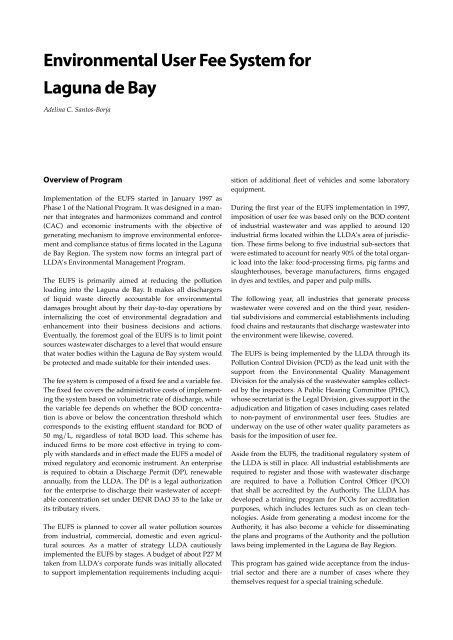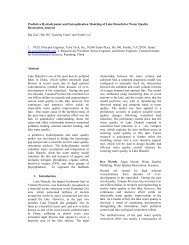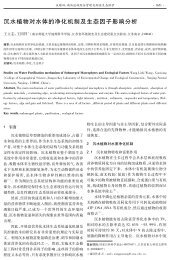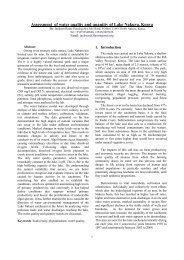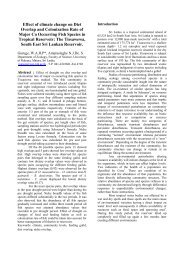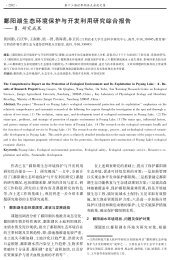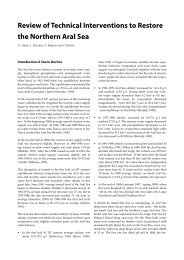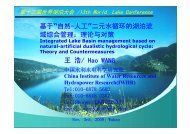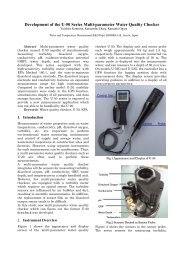Environmental User Fee System for Laguna de Bay
Environmental User Fee System for Laguna de Bay
Environmental User Fee System for Laguna de Bay
- No tags were found...
Create successful ePaper yourself
Turn your PDF publications into a flip-book with our unique Google optimized e-Paper software.
<strong>Environmental</strong> <strong>User</strong> <strong>Fee</strong> <strong>System</strong> <strong>for</strong><strong>Laguna</strong> <strong>de</strong> <strong>Bay</strong>A<strong>de</strong>lina C. Santos-BorjaOverview of ProgramImplementation of the EUFS started in January 1997 asPhase 1 of the National Program. It was <strong>de</strong>signed in a mannerthat integrates and harmonizes command and control(CAC) and economic instruments with the objective ofgenerating mechanism to improve environmental en<strong>for</strong>cementand compliance status of firms located in the <strong>Laguna</strong><strong>de</strong> <strong>Bay</strong> Region. The system now <strong>for</strong>ms an integral part ofLLDA’s <strong>Environmental</strong> Management Program.The EUFS is primarily aimed at reducing the pollutionloading into the <strong>Laguna</strong> <strong>de</strong> <strong>Bay</strong>. It makes all dischargersof liquid waste directly accountable <strong>for</strong> environmentaldamages brought about by their day-to-day operations byinternalizing the cost of environmental <strong>de</strong>gradation an<strong>de</strong>nhancement into their business <strong>de</strong>cisions and actions.Eventually, the <strong>for</strong>emost goal of the EUFS is to limit pointsources wastewater discharges to a level that would ensurethat water bodies within the <strong>Laguna</strong> <strong>de</strong> <strong>Bay</strong> system wouldbe protected and ma<strong>de</strong> suitable <strong>for</strong> their inten<strong>de</strong>d uses.The fee system is composed of a fixed fee and a variable fee.The fixed fee covers the administrative costs of implementingthe system based on volumetric rate of discharge, whilethe variable fee <strong>de</strong>pends on whether the BOD concentrationis above or below the concentration threshold whichcorresponds to the existing effluent standard <strong>for</strong> BOD of50 mg/L, regardless of total BOD load. This scheme hasinduced firms to be more cost effective in trying to complywith standards and in effect ma<strong>de</strong> the EUFS a mo<strong>de</strong>l ofmixed regulatory and economic instrument. An enterpriseis required to obtain a Discharge Permit (DP), renewableannually, from the LLDA. The DP is a legal authorization<strong>for</strong> the enterprise to discharge their wastewater of acceptableconcentration set un<strong>de</strong>r DENR DAO 35 to the lake orits tributary rivers.The EUFS is planned to cover all water pollution sourcesfrom industrial, commercial, domestic and even agriculturalsources. As a matter of strategy LLDA cautiouslyimplemented the EUFS by stages. A budget of about P27 Mtaken from LLDA’s corporate funds was initially allocatedto support implementation requirements including acquisitionof additional fleet of vehicles and some laboratoryequipment.During the first year of the EUFS implementation in 1997,imposition of user fee was based only on the BOD contentof industrial wastewater and was applied to around 120industrial firms located within the LLDA’s area of jurisdiction.These firms belong to five industrial sub-sectors thatwere estimated to account <strong>for</strong> nearly 90% of the total organicload into the lake: food-processing firms, pig farms andslaughterhouses, beverage manufacturers, firms engagedin dyes and textiles, and paper and pulp mills.The following year, all industries that generate processwastewater were covered and on the third year, resi<strong>de</strong>ntialsubdivisions and commercial establishments includingfood chains and restaurants that discharge wastewater intothe environment were likewise, covered.The EUFS is being implemented by the LLDA through itsPollution Control Division (PCD) as the lead unit with thesupport from the <strong>Environmental</strong> Quality ManagementDivision <strong>for</strong> the analysis of the wastewater samples collectedby the inspectors. A Public Hearing Committee (PHC),whose secretariat is the Legal Division, gives support in theadjudication and litigation of cases including cases relatedto non-payment of environmental user fees. Studies areun<strong>de</strong>rway on the use of other water quality parameters asbasis <strong>for</strong> the imposition of user fee.Asi<strong>de</strong> from the EUFS, the traditional regulatory system ofthe LLDA is still in place. All industrial establishments arerequired to register and those with wastewater dischargeare required to have a Pollution Control Officer (PCO)that shall be accredited by the Authority. The LLDA has<strong>de</strong>veloped a training program <strong>for</strong> PCOs <strong>for</strong> accreditationpurposes, which inclu<strong>de</strong>s lectures such as on clean technologies.Asi<strong>de</strong> from generating a mo<strong>de</strong>st income <strong>for</strong> theAuthority, it has also become a vehicle <strong>for</strong> disseminatingthe plans and programs of the Authority and the pollutionlaws being implemented in the <strong>Laguna</strong> <strong>de</strong> <strong>Bay</strong> Region.This program has gained wi<strong>de</strong> acceptance from the industrialsector and there are a number of cases where theythemselves request <strong>for</strong> a special training schedule.
Lessons LearnedThe LLDA’s experience in the implementation of the EUFStaught two important lessons: (i) start simple and buil<strong>de</strong>xperience; and (ii) the battle cry should be “READY, FIRE,AIM” rather than “READY, AIM, FIRE”. Thus, it is better tostart simple, just fine tune as experience builds up.The right way <strong>for</strong>ward <strong>for</strong> pollution charges/ user fees thatemerged are:• Simple, mo<strong>de</strong>st approach;• Sector-based pilot run to help in un<strong>de</strong>rstanding feasibilityaspects, administrative convenience, institutionalarrangements, acceptability by all stakehol<strong>de</strong>rs;• Pick one to two controllable parameters;• Revise charges based on results of monitoring;• Strong and credible regulatory arm with multi-stakehol<strong>de</strong>rorientation;• Pollution charges at all levels from zero discharge andincreasing above the effluent standards.The <strong>Environmental</strong> <strong>User</strong> <strong>Fee</strong> <strong>System</strong> has created a strongincentive <strong>for</strong> regulated firms to reduce the BOD concentrationof wastewater discharged into the lake. Un<strong>for</strong>tunately,it has also created an incentive <strong>for</strong> firms to dilute their discharges.This is a potential weakness of the system, and itsuggests the importance of properly pricing input water toavoid perverse responses to EUFS.It is the policy position of LLDA that Market BasedInstruments (MBIs) should not replace traditional regulatorysystems. Rather, they are to be used as complementarytools <strong>for</strong> promoting efficient use of resources. To leverageits unique experience in MBIs, the strategy is <strong>for</strong> LLDA is toexpand the <strong>Environmental</strong> <strong>User</strong> <strong>Fee</strong> <strong>System</strong> (EUFS) usingfour strategies:• Revising the existing <strong>for</strong>mula <strong>for</strong> industrial EUFS byintroducing other parameters in addition to BiochemicalOxygen Demand (BOD)• Exploring arrangements to inclu<strong>de</strong> the households inthe coverage of the EUFS• Exploring the opportunities <strong>for</strong> introducing EUFS <strong>for</strong>raw water extracted from the Lake• Public Disclosure ProgramDrawing on international and local experiences, a publicdisclosure program will be in place to create incentives<strong>for</strong> pollution control and improve the environmental per<strong>for</strong>manceof industrial polluters. This program is aimedto introduce the concept of public disclosure to LGUs andinclu<strong>de</strong> them in a program of monitoring and disclosureof environmental per<strong>for</strong>mance that will encourage themto invest in improving their environmental managementper<strong>for</strong>mance.Since the EUFS is implemented to complement the existingcommand and control approach <strong>for</strong> pollution control andabatement, administering the system vis-à-vis the existingregulatory system was administratively complex anddifficult to en<strong>for</strong>ce. In response to this concern, the LLDAhad to introduce policy refinements and clarifications intothe existing rules and regulations to ensure effective implementationof the <strong>System</strong> and en<strong>for</strong>cement of existing policiesand regulations.2 <strong>Environmental</strong> <strong>User</strong> <strong>Fee</strong> <strong>System</strong> <strong>for</strong> <strong>Laguna</strong> <strong>de</strong> <strong>Bay</strong>


